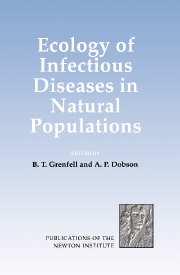Book contents
- Frontmatter
- Contents
- List of Participants
- Introduction
- BROAD PATTERNS AND PROCESSES
- PATHOGENS, INSECTS AND PLANTS
- IMPACT OF ECOLOGICAL AND GENETIC HETEROGENEITY
- Environmental Influences on Host Immunity
- Modelling the Immuno-Epidemiology of Macroparasites in Wildlife Host Populations
- Spatial Dynamics of Parasitism
- Spatial Dynamics Group Report
- Genetic Diversity in Host-Parasite Interactions
- Genetics and Evolution of Infectious Diseases in Natural Populations Group Report
- Beyond Host-Pathogen Dynamics
- Glossary
Environmental Influences on Host Immunity
Published online by Cambridge University Press: 22 January 2010
- Frontmatter
- Contents
- List of Participants
- Introduction
- BROAD PATTERNS AND PROCESSES
- PATHOGENS, INSECTS AND PLANTS
- IMPACT OF ECOLOGICAL AND GENETIC HETEROGENEITY
- Environmental Influences on Host Immunity
- Modelling the Immuno-Epidemiology of Macroparasites in Wildlife Host Populations
- Spatial Dynamics of Parasitism
- Spatial Dynamics Group Report
- Genetic Diversity in Host-Parasite Interactions
- Genetics and Evolution of Infectious Diseases in Natural Populations Group Report
- Beyond Host-Pathogen Dynamics
- Glossary
Summary
Introduction
In recent years, scientific understanding of the interactions within the immune system of laboratory animals and humans has advanced considerably. The level and nature of immune responses by wildlife hosts are also likely to be crucial in determining the impact of parasitism, both demographically (Dobson and Hudson this volume, Grenfell et al. this volume, Hudson and Dobson this volume) and in terms of host-parasite coevolution (Read et al. this volume). Unfortunately, the dynamics and implications of immunity are (largely for logistical reasons) relatively undocumented for most wildlife populations. This review therefore discusses the impact of immunological processes on wildlife diseases by analogy with the mass of information available from studies on humans, laboratory and farm animals. A particular focus will be the likely interaction of immunity with ecological and environmental influences on the host, for example, via nutritional stress, seasonality in reproduction or environmental pollution.
The first part of this review describes the immune mechanisms. These comprise the recognition of foreigness and processing of the antigens of the invading organisms; expansion of clones of lymphocytes; and recruitment and activation of effector systems (a variety of antibodies, macrophages, phagocytes, cytotoxic cells) to eliminate the organisms. A large number of molecules are released or cleaved to provide signals (cytokines, complement components) all of these having different interconnecting functions. Finally, there are regulatory interactions with feedback mechanisms (antibody, cytokines, suppressor cells) for down-regulation of a response. Details of these mechanisms are now becoming available for domestic animals, but only slowly for the very diverse wildlife populations. This review, therefore, draws an analogy for these latter from experimental/agricultural animal immune responses.
- Type
- Chapter
- Information
- Ecology of Infectious Diseases in Natural Populations , pp. 327 - 361Publisher: Cambridge University PressPrint publication year: 1995
- 30
- Cited by



